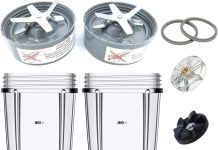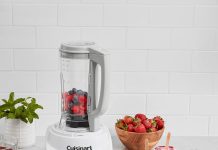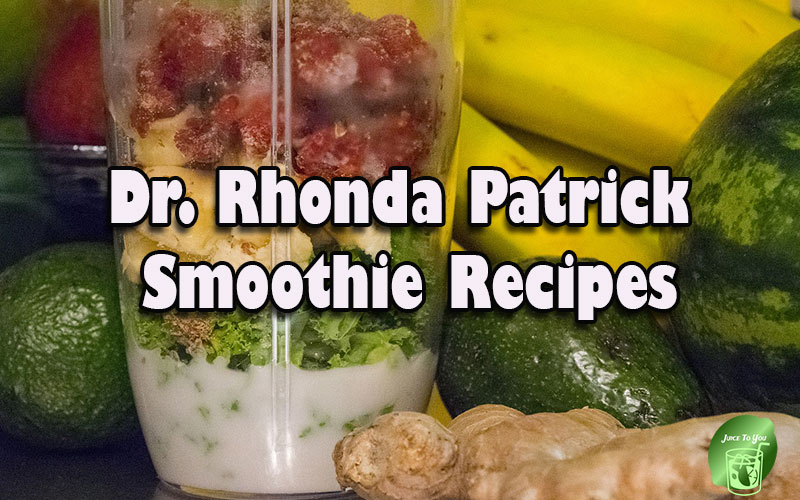In the world of healthy eating, there are always new trends and techniques emerging that promise to enhance our diets and nourish our bodies. One such debate that has been gaining attention is whether or not to soak nuts and seeds before blending them. Some argue that soaking can release nutrients, improve digestion, and even enhance the flavor of these nutritious ingredients. However, others believe that the benefits are minimal or even non-existent. Join us as we explore the pros and cons of soaking nuts and seeds and determine if it’s truly worth the extra step in your blending routine.
Review contents
Benefits of Soaking Nuts/Seeds
Increased Nutrient Absorption
Soaking nuts and seeds before consumption can increase the absorption of nutrients by our bodies. Nuts and seeds contain phytic acid, which can inhibit the absorption of essential minerals like iron, zinc, and calcium. By soaking them, we can reduce the phytic acid content, making it easier for our bodies to absorb these vital nutrients.
Improved Digestion
Soaking nuts and seeds also aids in digestion. Soaking helps to break down the complex carbohydrates and proteins present in nuts and seeds, making them easier to digest. This can be especially beneficial for individuals with digestive issues, such as bloating or gas, as soaking can help alleviate these symptoms.
Enhanced Texture
Soaked nuts and seeds have a softer texture compared to their raw counterparts. The soaking process hydrates the nuts and seeds, making them easier to chew and blend. Soaked nuts and seeds can lend a creamy consistency to recipes, especially when used in nut milk or dips like hummus.
Reduced Anti-Nutrients
Anti-nutrients, such as phytic acid and enzyme inhibitors, are naturally present in nuts and seeds. These substances can interfere with nutrient absorption and digestion. Soaking nuts and seeds helps to neutralize and reduce the levels of anti-nutrients, allowing for better nutrient intake and improved overall health.
Factors to Consider
Nut/Seed Type and Size
Different nuts and seeds have varying soaking times due to their size and composition. While larger nuts like almonds and walnuts may require longer soaking times, smaller seeds like chia or flaxseeds may need less soaking time. It’s important to consider the specific nut or seed you’re working with before determining the soaking duration.
Blender Power
The power and efficiency of your blender can impact the outcome of soaked nuts and seeds. A high-powered blender is ideal for achieving a smooth and creamy consistency when blending soaked nuts and seeds. If your blender is not powerful enough, you may end up with a grainy texture.
Time Constraints
Soaking nuts and seeds takes time, and it’s essential to plan accordingly. Some varieties may require soaking overnight, while others may need only a few hours. It’s important to consider your schedule and allow adequate time for soaking before incorporating them into your recipes.
Recipe Requirements
The recipe you’re preparing may also influence the soaking method and time needed for nuts and seeds. Some recipes may benefit from a longer soaking time to achieve a specific texture or flavor. It’s important to consider the requirements of your recipe when deciding on the soaking duration for your nuts and seeds.
Soaking Methods
Water Soaking
Water soaking is the most common and straightforward method of soaking nuts and seeds. Simply place the desired quantity of nuts or seeds in a bowl and cover them with filtered water. Allow them to soak for the recommended time. Drain and rinse thoroughly before using.
Salt Soaking
Salt soaking is often used for larger nuts like almonds. This method involves adding salt to the soaking water to help break down enzyme inhibitors. To use this method, add 1-2 teaspoons of salt per cup of water and let the nuts soak for the suggested time. Rinse thoroughly before using.
Acidulated Water Soaking
Acidulated water soaking is recommended for certain seeds like quinoa or buckwheat, which contain higher levels of anti-nutrients. For this method, add a small amount of an acidic liquid, such as lemon juice or apple cider vinegar, to the soaking water. The acid helps to neutralize the anti-nutrients. Soak for the suggested time and rinse before use.
Soaking Times
General Soaking Guidelines
While the specific soaking time can vary depending on the nut or seed, here are some general guidelines to follow:
- Nuts: 4-12 hours
- Almonds: 8-12 hours
- Cashews: 2-4 hours
- Peanuts: 2-4 hours
Specific Nut/Seed Soaking Times
It’s essential to consider the soaking times specific to the nuts or seeds you’re working with. Here are some common soaking times for different varieties:
- Almonds: 8-12 hours
- Cashews: 2-4 hours
- Walnuts: 4-8 hours
- Pecans: 4-8 hours
- Chia Seeds: 15-30 minutes
- Flaxseeds: 15-30 minutes
Keep in mind that these are general guidelines, and it’s always best to follow the specific instructions provided for the particular nut or seed you’re using.
Effects of Not Soaking
Harder to Digest
Not soaking nuts and seeds can make them harder to digest. The enzyme inhibitors and phytic acid present in raw nuts and seeds can be challenging for our digestive systems to break down. This can lead to digestive discomfort, such as bloating or gas, especially for individuals with sensitive stomachs.
Potential Nutrient Loss
When we don’t soak nuts and seeds before consumption, we may experience a potential loss of nutrients. Phytic acid, which is naturally present in raw nuts and seeds, can bind to essential minerals, making them harder for our bodies to absorb. Soaking helps to reduce the phytic acid content and increase nutrient absorption.
Blending Soaked Nuts/Seeds
Blender Selection
The quality of your blender plays a crucial role in achieving the desired consistency when blending soaked nuts and seeds. A high-powered blender, such as a Vitamix or Blendtec, can effectively break down the soaked nuts and seeds, resulting in a creamy texture. If you don’t have a high-powered blender, you may need to blend for longer or strain the mixture to remove any remaining grit.
Blending Techniques
To achieve a smooth texture when blending soaked nuts and seeds, it’s important to follow the proper techniques. Start by blending at a low speed and gradually increase to high, allowing the nuts and seeds to break down gradually. Stop and scrape down the sides of the blender jar as needed to ensure even blending.
Adding Liquid
If the consistency of your blended nuts and seeds is too thick, you can add some liquid to thin it out. This can be water, plant-based milk, or any other liquid that complements your recipe. Adjust the amount of liquid gradually until you reach the desired consistency.
Dehydrating Soaked Nuts/Seeds
Benefits of Dehydrating
Dehydrating soaked nuts and seeds can enhance their flavor and extend their shelf life. Dehydration removes excess moisture, resulting in a crispier texture and intensified flavors. Dehydrated nuts and seeds can be used as a snack or added to recipes for added texture and crunch.
Methods of Dehydration
Dehydrating soaked nuts and seeds can be done using a dehydrator or an oven. If using a dehydrator, spread the soaked nuts and seeds in a single layer on the dehydrator trays and follow the manufacturer’s instructions for temperature and time. If using an oven, spread the soaked nuts and seeds on a baking sheet lined with parchment paper and set the oven to the lowest temperature, usually between 120-170°F (49-77°C). Leave the oven door slightly ajar to allow moisture to escape, and periodically check the nuts and seeds for dryness.
Soaking vs. Sprouting
Comparison of Soaking and Sprouting
While soaking and sprouting both involve the soaking of nuts and seeds, there are distinct differences between the two methods. Soaking is a simpler process that primarily involves hydrating the nuts or seeds without allowing them to sprout. Sprouting, on the other hand, involves soaking the nuts or seeds and then allowing them to germinate, resulting in the growth of a sprout. Sprouting requires additional time and care, but it can increase the nutritional value of the nuts or seeds.
When to Choose Sprouting
If you are looking to maximize the nutritional benefits of nuts and seeds, sprouting may be a better option. Sprouted nuts and seeds have increased levels of enzymes, vitamins, and minerals compared to soaked nuts and seeds. However, sprouting requires more time, attention, and specific conditions, making it a more involved process.
Common Concerns
Mold Growth
One common concern when soaking nuts and seeds is the potential growth of mold. To prevent mold growth, it’s vital to use clean, filtered water and thoroughly rinse the nuts or seeds after soaking. Additionally, proper airflow during the dehydration process can help reduce the risk of mold. If you notice any signs of mold or an off smell, discard the soaked nuts or seeds immediately.
Oxidation
Another concern is the oxidation of soaked nuts and seeds. Once soaked, nuts and seeds become more susceptible to oxidation, which can affect their taste and nutritional value. To minimize oxidation, it’s recommended to consume or store the soaked nuts and seeds within a reasonable timeframe, preferably within a few days.
Storage Considerations
When storing soaked nuts and seeds, it’s important to keep them in an airtight container to prevent moisture and air exposure. Store them in a cool, dry place away from direct sunlight. If you choose to dehydrate the soaked nuts and seeds, ensure they are completely dried before storing to prevent spoilage.
Conclusion
The decision to soak nuts and seeds before blending depends on personal preference and individual needs. Soaking can enhance nutrient absorption, improve digestion, and result in a more enjoyable texture. However, it’s important to consider factors like nut/seed type, blender power, time constraints, and recipe requirements. Additionally, understanding the effects of not soaking, the techniques for blending and dehydrating, and the differences between soaking and sprouting can help make an informed choice. With proper storage and precautions, soaking nuts and seeds can contribute to a healthy and delicious culinary experience.



































